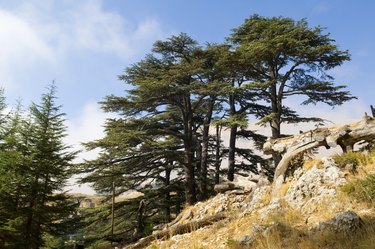
Not every tree called a cedar is one, so you want to know what type of tree you have before you decide how to prune a cedar tree. Although dozens of trees have common names that include the word "cedar," only four species of true cedars (Cedrus spp.) exist.
One is very rare and only grows on the isle of Cyprus, but Lebanon cedar (Cedrus libani, USDA hardiness zones 5-7), deodar cedar (Cedrus deodara, zones 7-9) and atlas cedar (Cedrus atlantica, zones 6-9) are cultivated in the U.S. While true cedars don't require regular trimming, it may be necessary to pick up the pruners on occasion.
Video of the Day
Video of the Day
True Cedar Trees
Don't confuse true cedars, native to the Middle and Far East, with "false cedars" and other trees that have"cedar" in their common names, which grow across the U.S. and populate numerous genera, including Calocedrus, Arborvitae, Chamaecyparis, and Juniperus. It's not difficult to tell them apart: Identify a true cedar by its dense evergreen needles at least an inch long, and the oblong cones up to 4 inches long that rise above the branches on little pegs.
While false cedars may require frequent pruning, true cedars do not. This is fortunate because true cedars can be forest giants, growing to 200 feet tall.
No Deep Pruning Advised
The general rule is that true cedars don't need to be pruned. While exceptions apply, cedars won't regrow if you prune deeper than the outer green branch tips. The dense growth creates a dead zone near the trunk where buds die from the shading. This means any trimming of a mature tree must be undertaken with care. Snip too much and you are left with a very sad looking, unattractive tree. Any tree shaping on true cedars should be accomplished while the tree is young.
Pruning for Branch Structure
Most true cedars don't require pruning to develop a strong structure. Lebanon, deodar and atlas cedars all grow in a soft pyramid shape with one central leader. If a young tree develops two leaders, the weaker one should be removed in favor of the stronger or better-formed one.
You'll need some basic tools to handle the pruning. Use bypass hand shears or hand pruners to prune a cedar tree for branch structure. Disinfect the cutting blade by wiping it with a rag soaked in isopropyl alcohol. Make the cut at the point the lesser leader emerges from the trunk. Don't apply wound balm or sealant, but allow the tree to heal itself.
Dead, Diseased, or Damaged Branches
You'll need to prune a cedar tree when branches have died or been damaged. No season is better than another for making these cuts, but wait for a few consecutive days of dry weather. Wet weather increases the likelihood of spreading disease spores.
Your top concern should be to avoid spreading pathogens from the damaged cedar branches. Sanitize the cutting blades of your pruner or handsaw before making each cut. Make the cut at least six inches into healthy wood. If the cut will be in the dead zone of the cedar, remove the branch at the trunk rather than leave a stub. Burn cut wood as quickly as possible after the pruning is done.
Pruning Cedar Trees for Size
In an ideal world, all trees would be planted with sufficient room for them to spread as they mature, but accidents happen. If you find yourself with a cedar expanding beyond its allotted bounds, you can do limited size pruning to contain the branches.
Reduce branch length by cutting off the branch tips, making the cut just above a lateral branchlet or bud. Be careful not to cut into the dead zone at the center of the tree; always make sure you leave at least a few green branches on the branch tip. Continue with other branches, maintaining an attractive and natural shaping. Sterilize the cutting blade before each cut.
Removing Lower Branches
All true cedars look more majestic and graceful when you leave the lower branches intact. If, however, your cedar is planted by a sidewalk or driveway, you may have to remove lower branches to permit passage.
Start with the lowest branch and work up as far as necessary. Use a hand saw that cuts on the pull, and sterilize it before each cut. Remove branches flush with the trunk.
For large branches, make three cuts, the first a foot from the trunk. Cut one-third of the way through the branch from the underside. Make the subsequent cut a few inches outside the first, severing the limb. The third cut should be flush with the trunk just outside the limb collar, the slight swelling at the base of the branch.